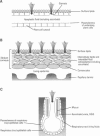Abstract
Atmospheric pollutants represent an important source of oxidative and nitrosative stress to both terrestrial plants and to animals. The exposed biosurfaces of plants and animals are directly exposed to these pollutant stresses. Not surprisingly, living organisms have developed complex integrated extracellular and intracellular defense systems against stresses related to reactive oxygen and nitrogen species (ROS, RNS), including O3 and NO2. Plant and animal epithelial surfaces and respiratory tract surfaces contain antioxidants that would be expected to provide defense against environmental stress caused by ambient ROS and RNS, thus ameliorating their injurious effects on more delicate underlying cellular constituents. Parallelisms among these surfaces with regard to their antioxidant constituents and environmental oxidants are presented. The reactive substances at these biosurfaces not only represent an important protective system against oxidizing environments, but products of their reactions with ROS/RNS may also serve as biomarkers of environmental oxidative stress. Moreover, the reaction products may also induce injury to underlying cells or cause cell activation, resulting in production of proinflammatory substances including cytokines. In this review we discuss antioxidant defense systems against environmental toxins in plant cell wall/apoplastic fluids, dead keratinized cells/interstitial fluids of stratum corneum (the outermost skin layer), and mucus/respiratory tract lining fluids.
Full text
PDF

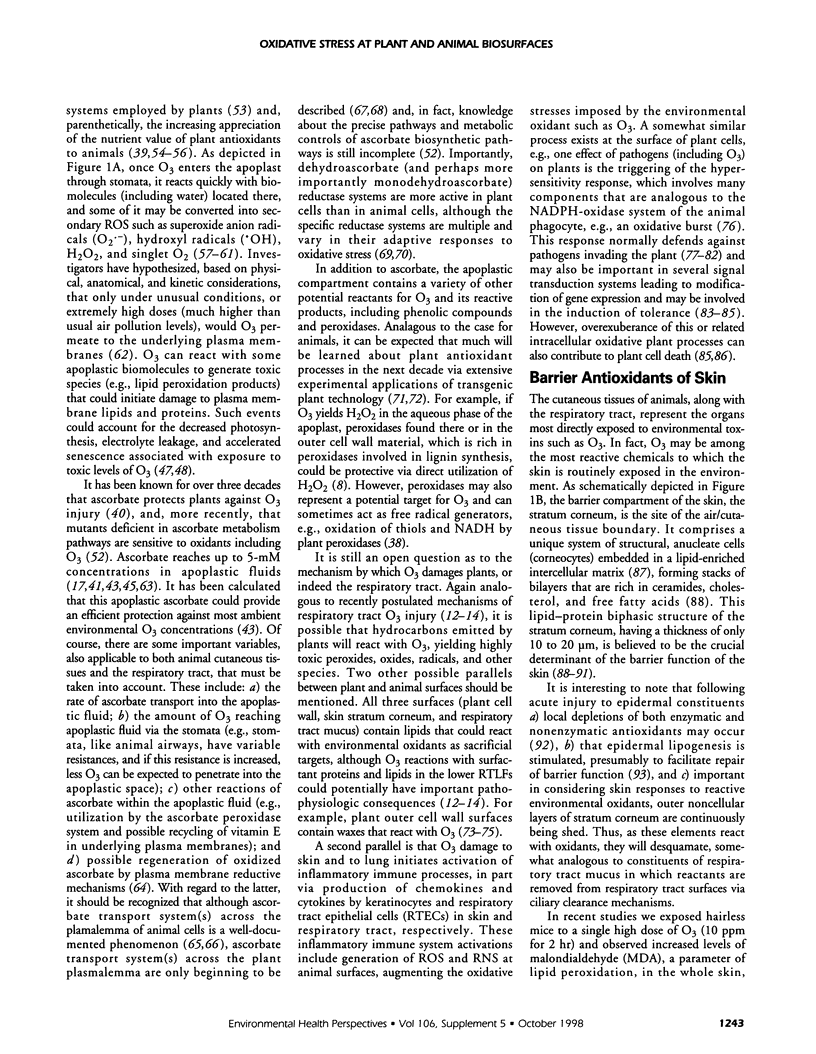

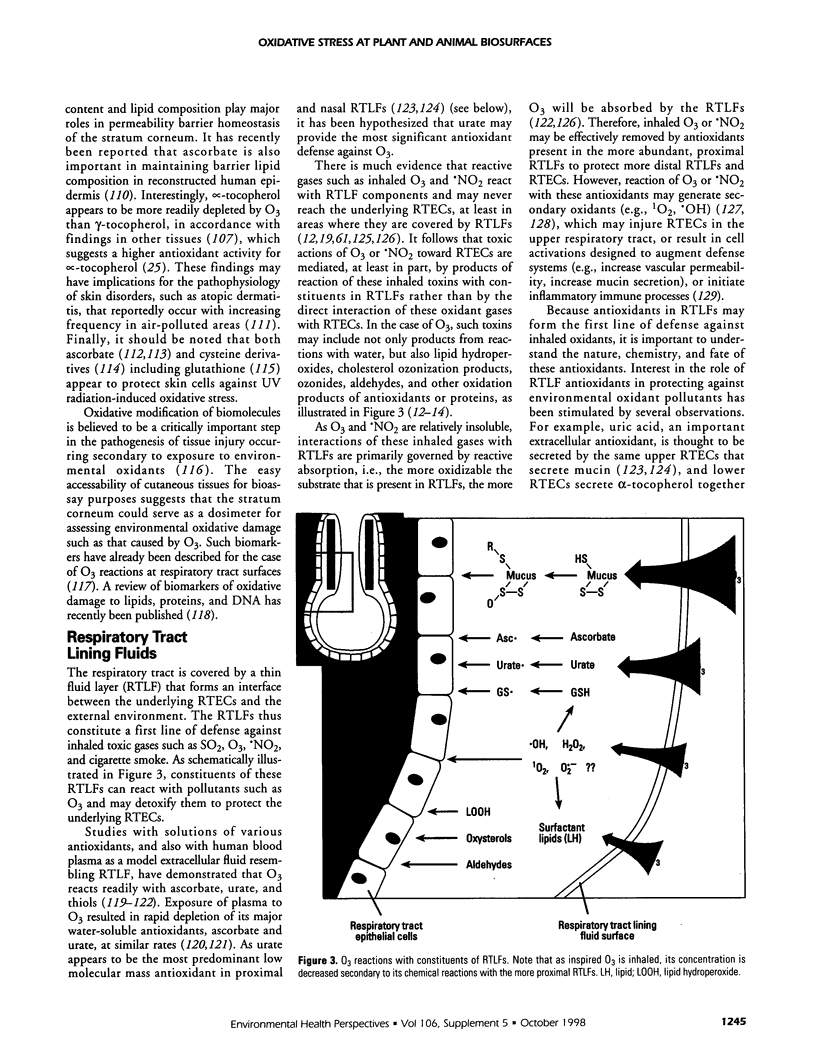

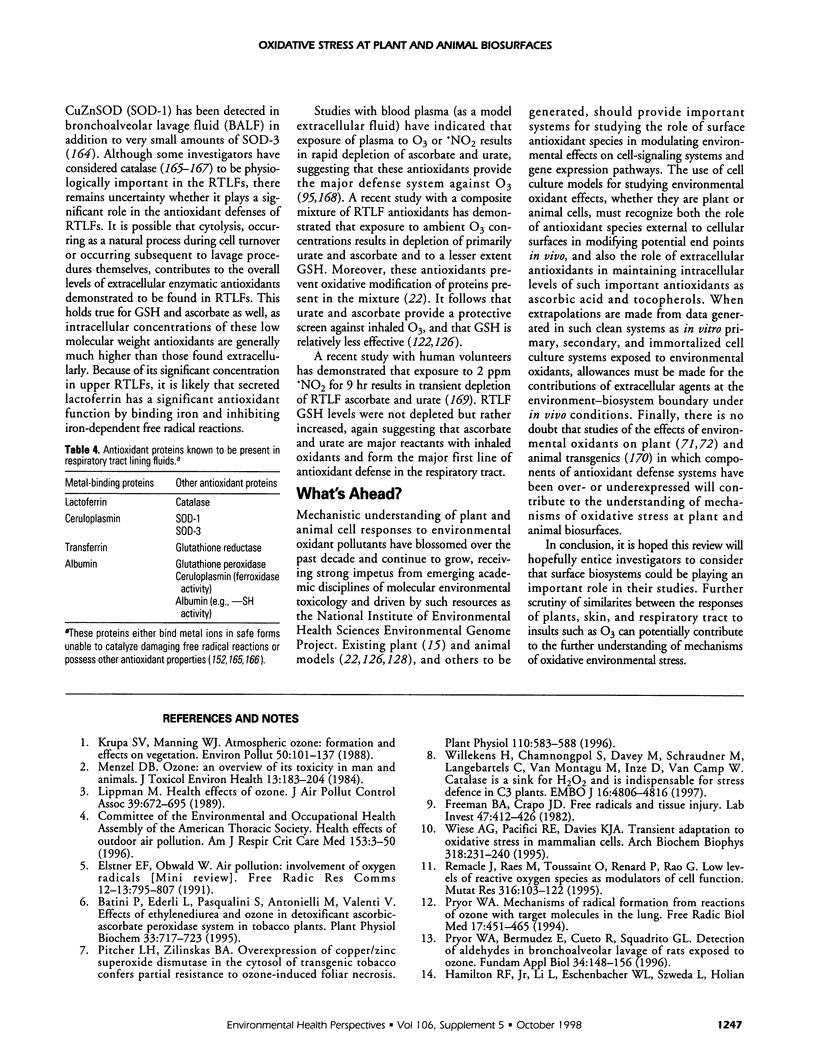
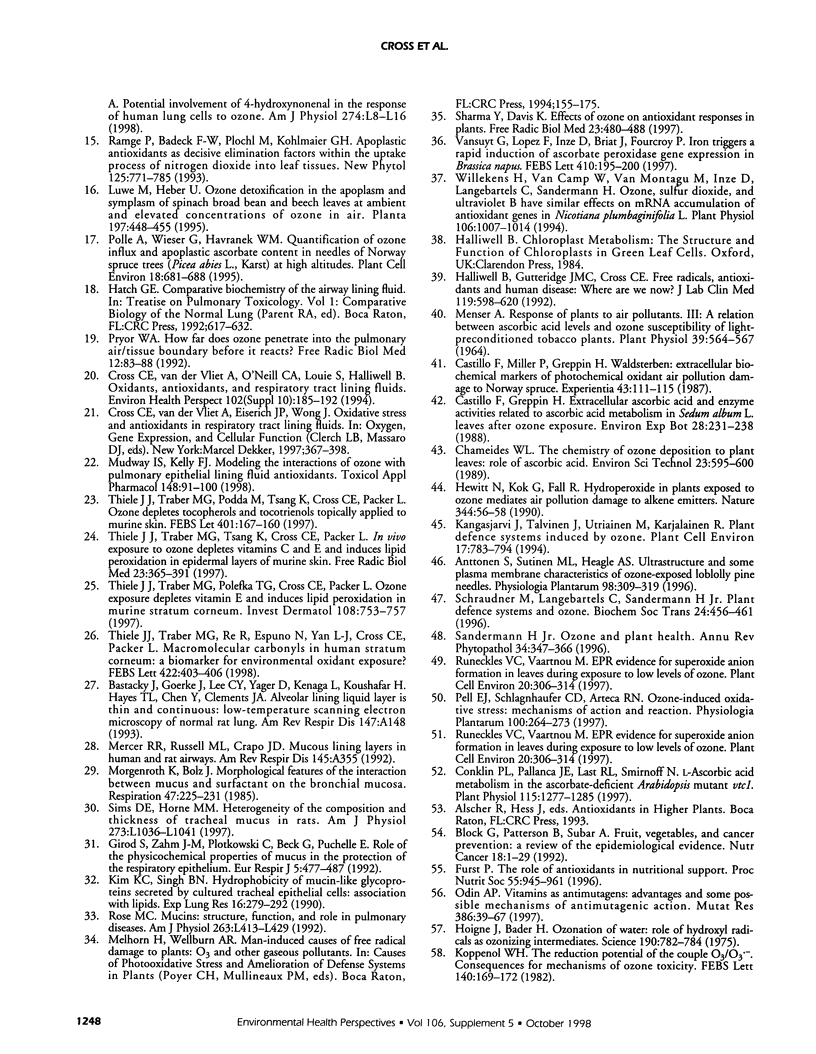

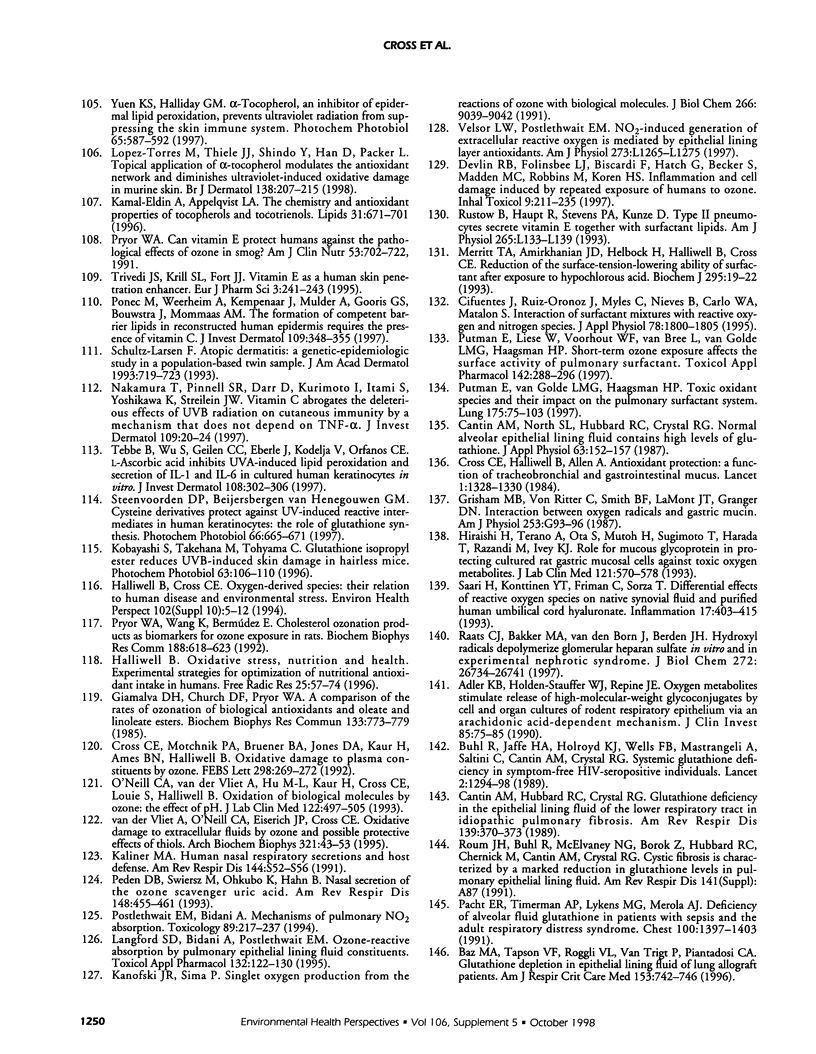
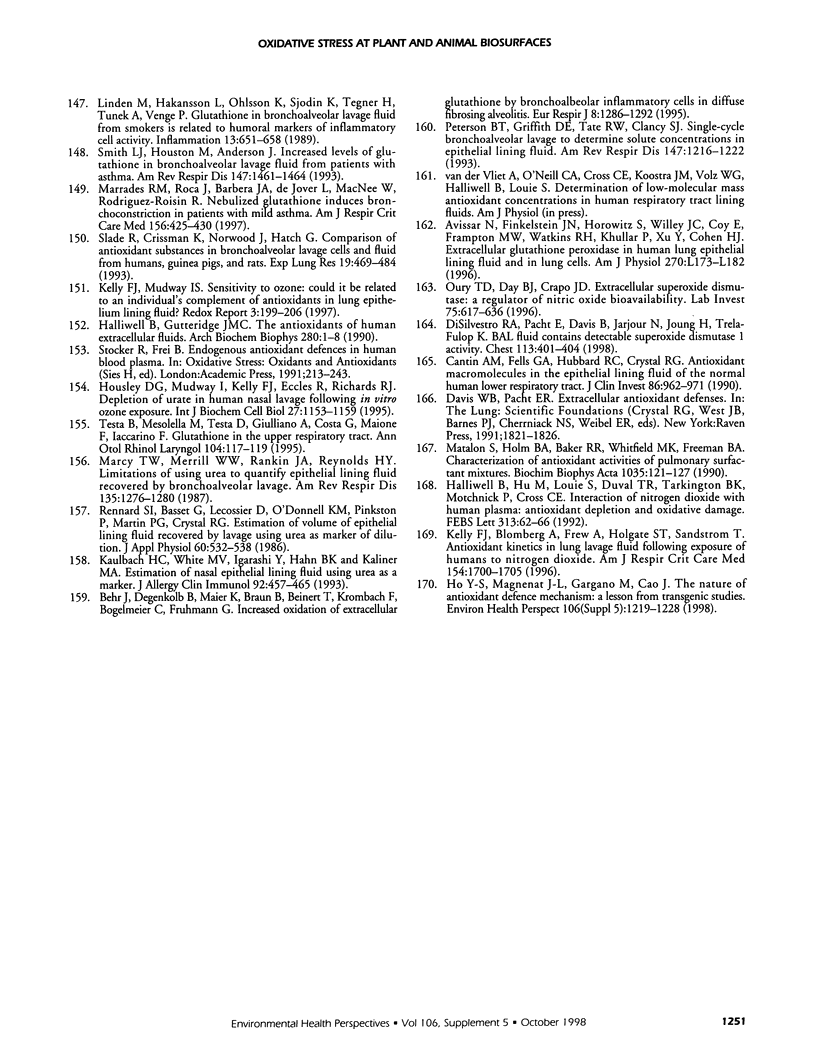
Images in this article
Selected References
These references are in PubMed. This may not be the complete list of references from this article.
- Adler K. B., Holden-Stauffer W. J., Repine J. E. Oxygen metabolites stimulate release of high-molecular-weight glycoconjugates by cell and organ cultures of rodent respiratory epithelium via an arachidonic acid-dependent mechanism. J Clin Invest. 1990 Jan;85(1):75–85. doi: 10.1172/JCI114436. [DOI] [PMC free article] [PubMed] [Google Scholar]
- Allan A. C., Fluhr R. Two Distinct Sources of Elicited Reactive Oxygen Species in Tobacco Epidermal Cells. Plant Cell. 1997 Sep;9(9):1559–1572. doi: 10.1105/tpc.9.9.1559. [DOI] [PMC free article] [PubMed] [Google Scholar]
- Allan A. C., Fluhr R. Two Distinct Sources of Elicited Reactive Oxygen Species in Tobacco Epidermal Cells. Plant Cell. 1997 Sep;9(9):1559–1572. doi: 10.1105/tpc.9.9.1559. [DOI] [PMC free article] [PubMed] [Google Scholar]
- Allen R. D., Webb R. P., Schake S. A. Use of transgenic plants to study antioxidant defenses. Free Radic Biol Med. 1997;23(3):473–479. doi: 10.1016/s0891-5849(97)00107-x. [DOI] [PubMed] [Google Scholar]
- Avissar N., Finkelstein J. N., Horowitz S., Willey J. C., Coy E., Frampton M. W., Watkins R. H., Khullar P., Xu Y. L., Cohen H. J. Extracellular glutathione peroxidase in human lung epithelial lining fluid and in lung cells. Am J Physiol. 1996 Feb;270(2 Pt 1):L173–L182. doi: 10.1152/ajplung.1996.270.2.L173. [DOI] [PubMed] [Google Scholar]
- Baz M. A., Tapson V. F., Roggli V. L., Van Trigt P., Piantadosi C. A. Glutathione depletion in epithelial lining fluid of lung allograft patients. Am J Respir Crit Care Med. 1996 Feb;153(2):742–746. doi: 10.1164/ajrccm.153.2.8564127. [DOI] [PubMed] [Google Scholar]
- Behr J., Degenkolb B., Maier K., Braun B., Beinert T., Krombach F., Vogelmeier C., Fruhmann G. Increased oxidation of extracellular glutathione by bronchoalveolar inflammatory cells in diffuse fibrosing alveolitis. Eur Respir J. 1995 Aug;8(8):1286–1292. doi: 10.1183/09031936.95.08081286. [DOI] [PubMed] [Google Scholar]
- Beijersbergen van Henegouwen G. M., Junginger H. E., de Vries H. Hydrolysis of RRR-alpha-tocopheryl acetate (vitamin E acetate) in the skin and its UV protecting activity (an in vivo study with the rat). J Photochem Photobiol B. 1995 Jul;29(1):45–51. doi: 10.1016/1011-1344(95)90251-1. [DOI] [PubMed] [Google Scholar]
- Block G., Patterson B., Subar A. Fruit, vegetables, and cancer prevention: a review of the epidemiological evidence. Nutr Cancer. 1992;18(1):1–29. doi: 10.1080/01635589209514201. [DOI] [PubMed] [Google Scholar]
- Bolwell G. P. The origin of the oxidative burst in plants. Biochem Soc Trans. 1996 May;24(2):438–442. doi: 10.1042/bst0240438. [DOI] [PubMed] [Google Scholar]
- Bommannan D., Potts R. O., Guy R. H. Examination of stratum corneum barrier function in vivo by infrared spectroscopy. J Invest Dermatol. 1990 Oct;95(4):403–408. doi: 10.1111/1523-1747.ep12555503. [DOI] [PubMed] [Google Scholar]
- Bouwstra J. A., Gooris G. S., Cheng K., Weerheim A., Bras W., Ponec M. Phase behavior of isolated skin lipids. J Lipid Res. 1996 May;37(5):999–1011. [PubMed] [Google Scholar]
- Broadbent P., Creissen G., Wellburn F. A., Mullineaux P. M., Wellburn A. R. Biochemical effects of tropospheric ozone in transgenic plants. Biochem Soc Trans. 1994 Nov;22(4):1020–1025. doi: 10.1042/bst0221020. [DOI] [PubMed] [Google Scholar]
- Buhl R., Jaffe H. A., Holroyd K. J., Wells F. B., Mastrangeli A., Saltini C., Cantin A. M., Crystal R. G. Systemic glutathione deficiency in symptom-free HIV-seropositive individuals. Lancet. 1989 Dec 2;2(8675):1294–1298. doi: 10.1016/s0140-6736(89)91909-0. [DOI] [PubMed] [Google Scholar]
- Byvoet P., Balis J. U., Shelley S. A., Montgomery M. R., Barber M. J. Detection of hydroxyl radicals upon interaction of ozone with aqueous media or extracellular surfactant: the role of trace iron. Arch Biochem Biophys. 1995 Jun 1;319(2):464–469. doi: 10.1006/abbi.1995.1318. [DOI] [PubMed] [Google Scholar]
- Bánhegyi G., Braun L., Csala M., Puskás F., Mandl J. Ascorbate metabolism and its regulation in animals. Free Radic Biol Med. 1997;23(5):793–803. doi: 10.1016/s0891-5849(97)00062-2. [DOI] [PubMed] [Google Scholar]
- Cantin A. M., Fells G. A., Hubbard R. C., Crystal R. G. Antioxidant macromolecules in the epithelial lining fluid of the normal human lower respiratory tract. J Clin Invest. 1990 Sep;86(3):962–971. doi: 10.1172/JCI114798. [DOI] [PMC free article] [PubMed] [Google Scholar]
- Cantin A. M., Hubbard R. C., Crystal R. G. Glutathione deficiency in the epithelial lining fluid of the lower respiratory tract in idiopathic pulmonary fibrosis. Am Rev Respir Dis. 1989 Feb;139(2):370–372. doi: 10.1164/ajrccm/139.2.370. [DOI] [PubMed] [Google Scholar]
- Cantin A. M., North S. L., Hubbard R. C., Crystal R. G. Normal alveolar epithelial lining fluid contains high levels of glutathione. J Appl Physiol (1985) 1987 Jul;63(1):152–157. doi: 10.1152/jappl.1987.63.1.152. [DOI] [PubMed] [Google Scholar]
- Chang J. Y., Liu L. Z. Toxicity of cholesterol oxides on cultured neuroretinal cells. Curr Eye Res. 1998 Jan;17(1):95–103. doi: 10.1076/ceyr.17.1.95.5252. [DOI] [PubMed] [Google Scholar]
- Cifuentes J., Ruiz-Oronoz J., Myles C., Nieves B., Carlo W. A., Matalon S. Interaction of surfactant mixtures with reactive oxygen and nitrogen species. J Appl Physiol (1985) 1995 May;78(5):1800–1805. doi: 10.1152/jappl.1995.78.5.1800. [DOI] [PubMed] [Google Scholar]
- Clement-Lacroix P., Michel L., Moysan A., Morliere P., Dubertret L. UVA-induced immune suppression in human skin: protective effect of vitamin E in human epidermal cells in vitro. Br J Dermatol. 1996 Jan;134(1):77–84. [PubMed] [Google Scholar]
- Conklin P. L., Last R. L. Differential accumulation of antioxidant mRNAs in Arabidopsis thaliana exposed to ozone. Plant Physiol. 1995 Sep;109(1):203–212. doi: 10.1104/pp.109.1.203. [DOI] [PMC free article] [PubMed] [Google Scholar]
- Conklin P. L., Pallanca J. E., Last R. L., Smirnoff N. L-ascorbic acid metabolism in the ascorbate-deficient arabidopsis mutant vtc1. Plant Physiol. 1997 Nov;115(3):1277–1285. doi: 10.1104/pp.115.3.1277. [DOI] [PMC free article] [PubMed] [Google Scholar]
- Cross C. E., Halliwell B., Allen A. Antioxidant protection: a function of tracheobronchial and gastrointestinal mucus. Lancet. 1984 Jun 16;1(8390):1328–1330. doi: 10.1016/s0140-6736(84)91822-1. [DOI] [PubMed] [Google Scholar]
- Cross C. E., Motchnik P. A., Bruener B. A., Jones D. A., Kaur H., Ames B. N., Halliwell B. Oxidative damage to plasma constituents by ozone. FEBS Lett. 1992 Feb 24;298(2-3):269–272. doi: 10.1016/0014-5793(92)80074-q. [DOI] [PubMed] [Google Scholar]
- Cross C. E., Motchnik P. A., Bruener B. A., Jones D. A., Kaur H., Ames B. N., Halliwell B. Oxidative damage to plasma constituents by ozone. FEBS Lett. 1992 Feb 24;298(2-3):269–272. doi: 10.1016/0014-5793(92)80074-q. [DOI] [PubMed] [Google Scholar]
- Cross C. E., van der Vliet A., O'Neill C. A., Louie S., Halliwell B. Oxidants, antioxidants, and respiratory tract lining fluids. Environ Health Perspect. 1994 Dec;102 (Suppl 10):185–191. doi: 10.1289/ehp.94102s10185. [DOI] [PMC free article] [PubMed] [Google Scholar]
- DiSilvestro R. A., Pacht E., Davis W. B., Jarjour N., Joung H., Trela-Fulop K. BAL fluid contains detectable superoxide dismutase 1 activity. Chest. 1998 Feb;113(2):401–404. doi: 10.1378/chest.113.2.401. [DOI] [PubMed] [Google Scholar]
- Dwyer S. C., Legendre L., Low P. S., Leto T. L. Plant and human neutrophil oxidative burst complexes contain immunologically related proteins. Biochim Biophys Acta. 1996 Mar 15;1289(2):231–237. doi: 10.1016/0304-4165(95)00156-5. [DOI] [PubMed] [Google Scholar]
- Elias P. M., Feingold K. R. Lipids and the epidermal water barrier: metabolism, regulation, and pathophysiology. Semin Dermatol. 1992 Jun;11(2):176–182. [PubMed] [Google Scholar]
- Elstner E. F., Osswald W. Air pollution: involvement of oxygen radicals (a mini review). Free Radic Res Commun. 1991;12-13 Pt 2:795–807. doi: 10.3109/10715769109145861. [DOI] [PubMed] [Google Scholar]
- Frederiks W. M., Ankum M., Bosch K. S., Vreeling-Sindelárová H., Schellens J. P., Van Noorden C. J. A cytophotometric and electron-microscopical study on catalase activity in serial cryostat sections of rat liver. Histochem J. 1995 Sep;27(9):681–688. [PubMed] [Google Scholar]
- Freeman B. A., Crapo J. D. Biology of disease: free radicals and tissue injury. Lab Invest. 1982 Nov;47(5):412–426. [PubMed] [Google Scholar]
- Fürst P. The role of antioxidants in nutritional support. Proc Nutr Soc. 1996 Nov;55(3):945–961. doi: 10.1079/pns19960091. [DOI] [PubMed] [Google Scholar]
- Giamalva D., Church D. F., Pryor W. A. A comparison of the rates of ozonation of biological antioxidants and oleate and linoleate esters. Biochem Biophys Res Commun. 1985 Dec 17;133(2):773–779. doi: 10.1016/0006-291x(85)90971-4. [DOI] [PubMed] [Google Scholar]
- Girod S., Zahm J. M., Plotkowski C., Beck G., Puchelle E. Role of the physiochemical properties of mucus in the protection of the respiratory epithelium. Eur Respir J. 1992 Apr;5(4):477–487. [PubMed] [Google Scholar]
- Goldenberg H., Schweinzer E. Transport of vitamin C in animal and human cells. J Bioenerg Biomembr. 1994 Aug;26(4):359–367. doi: 10.1007/BF00762776. [DOI] [PubMed] [Google Scholar]
- Goldman R., Moshonov S., Zor U. Generation of reactive oxygen species in a human keratinocyte cell line: role of calcium. Arch Biochem Biophys. 1998 Feb 1;350(1):10–18. doi: 10.1006/abbi.1997.0478. [DOI] [PubMed] [Google Scholar]
- Grimes H. D., Perkins K. K., Boss W. F. Ozone Degrades into Hydroxyl Radical under Physiological Conditions : A Spin Trapping Study. Plant Physiol. 1983 Aug;72(4):1016–1020. doi: 10.1104/pp.72.4.1016. [DOI] [PMC free article] [PubMed] [Google Scholar]
- Grubauer G., Feingold K. R., Elias P. M. Relationship of epidermal lipogenesis to cutaneous barrier function. J Lipid Res. 1987 Jun;28(6):746–752. [PubMed] [Google Scholar]
- Halliwell B., Cross C. E. Oxygen-derived species: their relation to human disease and environmental stress. Environ Health Perspect. 1994 Dec;102 (Suppl 10):5–12. doi: 10.1289/ehp.94102s105. [DOI] [PMC free article] [PubMed] [Google Scholar]
- Halliwell B., Gutteridge J. M., Cross C. E. Free radicals, antioxidants, and human disease: where are we now? J Lab Clin Med. 1992 Jun;119(6):598–620. [PubMed] [Google Scholar]
- Halliwell B., Gutteridge J. M. The antioxidants of human extracellular fluids. Arch Biochem Biophys. 1990 Jul;280(1):1–8. doi: 10.1016/0003-9861(90)90510-6. [DOI] [PubMed] [Google Scholar]
- Halliwell B., Hu M. L., Louie S., Duvall T. R., Tarkington B. K., Motchnik P., Cross C. E. Interaction of nitrogen dioxide with human plasma. Antioxidant depletion and oxidative damage. FEBS Lett. 1992 Nov 16;313(1):62–66. doi: 10.1016/0014-5793(92)81185-o. [DOI] [PubMed] [Google Scholar]
- Halliwell B. Oxidative stress, nutrition and health. Experimental strategies for optimization of nutritional antioxidant intake in humans. Free Radic Res. 1996 Jul;25(1):57–74. doi: 10.3109/10715769609145656. [DOI] [PubMed] [Google Scholar]
- Hiraishi H., Terano A., Ota S., Mutoh H., Sugimoto T., Harada T., Razandi M., Ivey K. J. Role for mucous glycoprotein in protecting cultured rat gastric mucosal cells against toxic oxygen metabolites. J Lab Clin Med. 1993 Apr;121(4):570–578. [PubMed] [Google Scholar]
- Ho Y. S., Magnenat J. L., Gargano M., Cao J. The nature of antioxidant defense mechanisms: a lesson from transgenic studies. Environ Health Perspect. 1998 Oct;106 (Suppl 5):1219–1228. doi: 10.1289/ehp.98106s51219. [DOI] [PMC free article] [PubMed] [Google Scholar]
- Horemans N., Asard H., Caubergs R. J. The Ascorbate Carrier of Higher Plant Plasma Membranes Preferentially Translocates the Fully Oxidized (Dehydroascorbate) Molecule. Plant Physiol. 1997 Aug;114(4):1247–1253. doi: 10.1104/pp.114.4.1247. [DOI] [PMC free article] [PubMed] [Google Scholar]
- Housley D. G., Mudway I., Kelly F. J., Eccles R., Richards R. J. Depletion of urate in human nasal lavage following in vitro ozone exposure. Int J Biochem Cell Biol. 1995 Nov;27(11):1153–1159. doi: 10.1016/1357-2725(95)00089-8. [DOI] [PubMed] [Google Scholar]
- Kaliner M. A. Human nasal respiratory secretions and host defense. Am Rev Respir Dis. 1991 Sep;144(3 Pt 2):S52–S56. doi: 10.1164/ajrccm/144.3_pt_2.S52. [DOI] [PubMed] [Google Scholar]
- Kamal-Eldin A., Appelqvist L. A. The chemistry and antioxidant properties of tocopherols and tocotrienols. Lipids. 1996 Jul;31(7):671–701. doi: 10.1007/BF02522884. [DOI] [PubMed] [Google Scholar]
- Kanofsky J. R., Sima P. D. Reactive absorption of ozone by aqueous biomolecule solutions: implications for the role of sulfhydryl compounds as targets for ozone. Arch Biochem Biophys. 1995 Jan 10;316(1):52–62. doi: 10.1006/abbi.1995.1009. [DOI] [PubMed] [Google Scholar]
- Kanofsky J. R., Sima P. Singlet oxygen production from the reactions of ozone with biological molecules. J Biol Chem. 1991 May 15;266(14):9039–9042. [PubMed] [Google Scholar]
- Kaulbach H. C., White M. V., Igarashi Y., Hahn B. K., Kaliner M. A. Estimation of nasal epithelial lining fluid using urea as a marker. J Allergy Clin Immunol. 1993 Sep;92(3):457–465. doi: 10.1016/0091-6749(93)90125-y. [DOI] [PubMed] [Google Scholar]
- Kelly F. J., Blomberg A., Frew A., Holgate S. T., Sandstrom T. Antioxidant kinetics in lung lavage fluid following exposure of humans to nitrogen dioxide. Am J Respir Crit Care Med. 1996 Dec;154(6 Pt 1):1700–1705. doi: 10.1164/ajrccm.154.6.8970358. [DOI] [PubMed] [Google Scholar]
- Kim K. C., Singh B. N. Hydrophobicity of mucin-like glycoproteins secreted by cultured tracheal epithelial cells: association with lipids. Exp Lung Res. 1990 May-Jun;16(3):279–292. doi: 10.3109/01902149009108845. [DOI] [PubMed] [Google Scholar]
- Kobayashi S., Takehana M., Tohyama C. Glutathione isopropyl ester reduces UVB-induced skin damage in hairless mice. Photochem Photobiol. 1996 Jan;63(1):106–110. doi: 10.1111/j.1751-1097.1996.tb02999.x. [DOI] [PubMed] [Google Scholar]
- Koppenol W. H. The reduction potential of the couple O3/O3. Consequences for mechanisms of ozone toxicity. FEBS Lett. 1982 Apr 19;140(2):169–172. doi: 10.1016/0014-5793(82)80886-7. [DOI] [PubMed] [Google Scholar]
- Krupa S. V., Manning W. J. Atmospheric ozone: formation and effects on vegetation. Environ Pollut. 1988;50(1-2):101–137. doi: 10.1016/0269-7491(88)90187-x. [DOI] [PubMed] [Google Scholar]
- Laisk A., Kull O., Moldau H. Ozone concentration in leaf intercellular air spaces is close to zero. Plant Physiol. 1989 Jul;90(3):1163–1167. doi: 10.1104/pp.90.3.1163. [DOI] [PMC free article] [PubMed] [Google Scholar]
- Langford S. D., Bidani A., Postlethwait E. M. Ozone-reactive absorption by pulmonary epithelial lining fluid constituents. Toxicol Appl Pharmacol. 1995 May;132(1):122–130. doi: 10.1006/taap.1995.1093. [DOI] [PubMed] [Google Scholar]
- Levine A., Tenhaken R., Dixon R., Lamb C. H2O2 from the oxidative burst orchestrates the plant hypersensitive disease resistance response. Cell. 1994 Nov 18;79(4):583–593. doi: 10.1016/0092-8674(94)90544-4. [DOI] [PubMed] [Google Scholar]
- Linden M., Håkansson L., Ohlsson K., Sjödin K., Tegner H., Tunek A., Venge P. Glutathione in bronchoalveolar lavage fluid from smokers is related to humoral markers of inflammatory cell activity. Inflammation. 1989 Dec;13(6):651–658. doi: 10.1007/BF00914309. [DOI] [PubMed] [Google Scholar]
- Lopez-Torres M., Thiele J. J., Shindo Y., Han D., Packer L. Topical application of alpha-tocopherol modulates the antioxidant network and diminishes ultraviolet-induced oxidative damage in murine skin. Br J Dermatol. 1998 Feb;138(2):207–215. doi: 10.1046/j.1365-2133.1998.02062.x. [DOI] [PubMed] [Google Scholar]
- Lüthje S., Döring O., Heuer S., Lüthen H., Böttger M. Oxidoreductases in plant plasma membranes. Biochim Biophys Acta. 1997 Mar 14;1331(1):81–102. doi: 10.1016/s0304-4157(96)00016-0. [DOI] [PubMed] [Google Scholar]
- Lütz C., Heinzmann U., Gülz P. G. Surface structures and epicuticular wax composition of spruce needles after long-term treatment with ozone and acid mist. Environ Pollut. 1990;64(3-4):313–322. doi: 10.1016/0269-7491(90)90053-f. [DOI] [PubMed] [Google Scholar]
- Man MQ M., Feingold K. R., Thornfeldt C. R., Elias P. M. Optimization of physiological lipid mixtures for barrier repair. J Invest Dermatol. 1996 May;106(5):1096–1101. doi: 10.1111/1523-1747.ep12340135. [DOI] [PubMed] [Google Scholar]
- Marcy T. W., Merrill W. W., Rankin J. A., Reynolds H. Y. Limitations of using urea to quantify epithelial lining fluid recovered by bronchoalveolar lavage. Am Rev Respir Dis. 1987 Jun;135(6):1276–1280. doi: 10.1164/arrd.1987.135.6.1276. [DOI] [PubMed] [Google Scholar]
- Marrades R. M., Roca J., Barberà J. A., de Jover L., MacNee W., Rodriguez-Roisin R. Nebulized glutathione induces bronchoconstriction in patients with mild asthma. Am J Respir Crit Care Med. 1997 Aug;156(2 Pt 1):425–430. doi: 10.1164/ajrccm.156.2.9611001. [DOI] [PubMed] [Google Scholar]
- Matalon S., Holm B. A., Baker R. R., Whitfield M. K., Freeman B. A. Characterization of antioxidant activities of pulmonary surfactant mixtures. Biochim Biophys Acta. 1990 Aug 17;1035(2):121–127. doi: 10.1016/0304-4165(90)90105-6. [DOI] [PubMed] [Google Scholar]
- Menser H. A. Response of Plants to Air Pollutants. III. A Relation between Ascorbic Acid Levels and Ozone Susceptibility of Light-Preconditioned Tobacco Plants. Plant Physiol. 1964 Jul;39(4):564–567. doi: 10.1104/pp.39.4.564. [DOI] [PMC free article] [PubMed] [Google Scholar]
- Menzel D. B. Ozone: an overview of its toxicity in man and animals. J Toxicol Environ Health. 1984;13(2-3):183–204. [PubMed] [Google Scholar]
- Merritt T. A., Amirkhanian J. D., Helbock H., Halliwell B., Cross C. E. Reduction of the surface-tension-lowering ability of surfactant after exposure to hypochlorous acid. Biochem J. 1993 Oct 1;295(Pt 1):19–22. doi: 10.1042/bj2950019. [DOI] [PMC free article] [PubMed] [Google Scholar]
- Morell S., Follmann H., De Tullio M., Häberlein I. Dehydroascorbate and dehydroascorbate reductase are phantom indicators of oxidative stress in plants. FEBS Lett. 1997 Sep 15;414(3):567–570. doi: 10.1016/s0014-5793(97)01074-0. [DOI] [PubMed] [Google Scholar]
- Morgenroth K., Bolz J. Morphological features of the interaction between mucus and surfactant on the bronchial mucosa. Respiration. 1985;47(3):225–231. doi: 10.1159/000194774. [DOI] [PubMed] [Google Scholar]
- Mudd J. B., Dawson P. J., Santrock J. Ozone does not react with human erythrocyte membrane lipids. Arch Biochem Biophys. 1997 May 15;341(2):251–258. doi: 10.1006/abbi.1997.9971. [DOI] [PubMed] [Google Scholar]
- Mudway I. S., Kelly F. J. Modeling the interactions of ozone with pulmonary epithelial lining fluid antioxidants. Toxicol Appl Pharmacol. 1998 Jan;148(1):91–100. doi: 10.1006/taap.1997.8318. [DOI] [PubMed] [Google Scholar]
- Nakamura T., Pinnell S. R., Darr D., Kurimoto I., Itami S., Yoshikawa K., Streilein J. W. Vitamin C abrogates the deleterious effects of UVB radiation on cutaneous immunity by a mechanism that does not depend on TNF-alpha. J Invest Dermatol. 1997 Jul;109(1):20–24. doi: 10.1111/1523-1747.ep12276349. [DOI] [PubMed] [Google Scholar]
- O'Neill C. A., van der Vliet A., Hu M. L., Kaur H., Cross C. E., Louie S., Halliwell B. Oxidation of biologic molecules by ozone: the effect of pH. J Lab Clin Med. 1993 Nov;122(5):497–505. [PubMed] [Google Scholar]
- Odin A. P. Vitamins as antimutagens: advantages and some possible mechanisms of antimutagenic action. Mutat Res. 1997 Mar;386(1):39–67. doi: 10.1016/s1383-5742(96)00044-0. [DOI] [PubMed] [Google Scholar]
- Orvar B. L., McPherson J., Ellis B. E. Pre-activating wounding response in tobacco prior to high-level ozone exposure prevents necrotic injury. Plant J. 1997 Feb;11(2):203–212. doi: 10.1046/j.1365-313x.1997.11020203.x. [DOI] [PubMed] [Google Scholar]
- Oury T. D., Day B. J., Crapo J. D. Extracellular superoxide dismutase: a regulator of nitric oxide bioavailability. Lab Invest. 1996 Nov;75(5):617–636. [PubMed] [Google Scholar]
- Pacht E. R., Timerman A. P., Lykens M. G., Merola A. J. Deficiency of alveolar fluid glutathione in patients with sepsis and the adult respiratory distress syndrome. Chest. 1991 Nov;100(5):1397–1403. doi: 10.1378/chest.100.5.1397. [DOI] [PubMed] [Google Scholar]
- Peden D. B., Swiersz M., Ohkubo K., Hahn B., Emery B., Kaliner M. A. Nasal secretion of the ozone scavenger uric acid. Am Rev Respir Dis. 1993 Aug;148(2):455–461. doi: 10.1164/ajrccm/148.2.455. [DOI] [PubMed] [Google Scholar]
- Pentland A. P. Signal transduction mechanisms in photocarcinogenesis. Photochem Photobiol. 1996 Apr;63(4):379–380. doi: 10.1111/j.1751-1097.1996.tb03048.x. [DOI] [PubMed] [Google Scholar]
- Peterson B. T., Griffith D. E., Tate R. W., Clancy S. J. Single-cycle bronchoalveolar lavage to determine solute concentrations in epithelial lining fluid. Am Rev Respir Dis. 1993 May;147(5):1216–1222. doi: 10.1164/ajrccm/147.5.1216. [DOI] [PubMed] [Google Scholar]
- Pirot F., Kalia Y. N., Stinchcomb A. L., Keating G., Bunge A., Guy R. H. Characterization of the permeability barrier of human skin in vivo. Proc Natl Acad Sci U S A. 1997 Feb 18;94(4):1562–1567. doi: 10.1073/pnas.94.4.1562. [DOI] [PMC free article] [PubMed] [Google Scholar]
- Pitcher L. H., Zilinskas B. A. Overexpression of Copper/Zinc Superoxide Dismutase in the Cytosol of Transgenic Tobacco Confers Partial Resistance to Ozone-Induced Foliar Necrosis. Plant Physiol. 1996 Feb;110(2):583–588. doi: 10.1104/pp.110.2.583. [DOI] [PMC free article] [PubMed] [Google Scholar]
- Ponec M., Weerheim A., Kempenaar J., Mulder A., Gooris G. S., Bouwstra J., Mommaas A. M. The formation of competent barrier lipids in reconstructed human epidermis requires the presence of vitamin C. J Invest Dermatol. 1997 Sep;109(3):348–355. doi: 10.1111/1523-1747.ep12336024. [DOI] [PubMed] [Google Scholar]
- Postlethwait E. M., Bidani A. Mechanisms of pulmonary NO2 absorption. Toxicology. 1994 May 20;89(3):217–237. doi: 10.1016/0300-483x(94)90099-x. [DOI] [PubMed] [Google Scholar]
- Pryor W. A., Bermúdez E., Cueto R., Squadrito G. L. Detection of aldehydes in bronchoalveolar lavage of rats exposed to ozone. Fundam Appl Toxicol. 1996 Nov;34(1):148–156. doi: 10.1006/faat.1996.0185. [DOI] [PubMed] [Google Scholar]
- Pryor W. A. Can vitamin E protect humans against the pathological effects of ozone in smog? Am J Clin Nutr. 1991 Mar;53(3):702–722. doi: 10.1093/ajcn/53.3.702. [DOI] [PubMed] [Google Scholar]
- Pryor W. A. How far does ozone penetrate into the pulmonary air/tissue boundary before it reacts? Free Radic Biol Med. 1992;12(1):83–88. doi: 10.1016/0891-5849(92)90060-t. [DOI] [PubMed] [Google Scholar]
- Pryor W. A. Mechanisms of radical formation from reactions of ozone with target molecules in the lung. Free Radic Biol Med. 1994 Nov;17(5):451–465. doi: 10.1016/0891-5849(94)90172-4. [DOI] [PubMed] [Google Scholar]
- Pryor W. A., Squadrito G. L., Friedman M. A new mechanism for the toxicity of ozone. Toxicol Lett. 1995 Dec;82-83:287–293. doi: 10.1016/0378-4274(95)03563-x. [DOI] [PubMed] [Google Scholar]
- Pryor W. A., Wang K., Bermúdez E. Cholesterol ozonation products as biomarkers for ozone exposure in rats. Biochem Biophys Res Commun. 1992 Oct 30;188(2):618–623. doi: 10.1016/0006-291x(92)91101-u. [DOI] [PubMed] [Google Scholar]
- Putman E., Liese W., Voorhout W. F., van Bree L., van Golde L. M., Haagsman H. P. Short-term ozone exposure affects the surface activity of pulmonary surfactant. Toxicol Appl Pharmacol. 1997 Feb;142(2):288–296. doi: 10.1006/taap.1996.8038. [DOI] [PubMed] [Google Scholar]
- Putman E., van Golde L. M., Haagsman H. P. Toxic oxidant species and their impact on the pulmonary surfactant system. Lung. 1997;175(2):75–103. doi: 10.1007/pl00007561. [DOI] [PubMed] [Google Scholar]
- Raats C. J., Bakker M. A., van den Born J., Berden J. H. Hydroxyl radicals depolymerize glomerular heparan sulfate in vitro and in experimental nephrotic syndrome. J Biol Chem. 1997 Oct 17;272(42):26734–26741. doi: 10.1074/jbc.272.42.26734. [DOI] [PubMed] [Google Scholar]
- Remacle J., Raes M., Toussaint O., Renard P., Rao G. Low levels of reactive oxygen species as modulators of cell function. Mutat Res. 1995 Feb;316(3):103–122. doi: 10.1016/0921-8734(95)90004-7. [DOI] [PubMed] [Google Scholar]
- Rennard S. I., Basset G., Lecossier D., O'Donnell K. M., Pinkston P., Martin P. G., Crystal R. G. Estimation of volume of epithelial lining fluid recovered by lavage using urea as marker of dilution. J Appl Physiol (1985) 1986 Feb;60(2):532–538. doi: 10.1152/jappl.1986.60.2.532. [DOI] [PubMed] [Google Scholar]
- Rose M. C. Mucins: structure, function, and role in pulmonary diseases. Am J Physiol. 1992 Oct;263(4 Pt 1):L413–L429. doi: 10.1152/ajplung.1992.263.4.L413. [DOI] [PubMed] [Google Scholar]
- Rüstow B., Haupt R., Stevens P. A., Kunze D. Type II pneumocytes secrete vitamin E together with surfactant lipids. Am J Physiol. 1993 Aug;265(2 Pt 1):L133–L139. doi: 10.1152/ajplung.1993.265.2.L133. [DOI] [PubMed] [Google Scholar]
- Saari H., Konttinen Y. T., Friman C., Sorsa T. Differential effects of reactive oxygen species on native synovial fluid and purified human umbilical cord hyaluronate. Inflammation. 1993 Aug;17(4):403–415. doi: 10.1007/BF00916581. [DOI] [PubMed] [Google Scholar]
- Sandermann H., Jr Ozone and plant health. Annu Rev Phytopathol. 1996;34:347–366. doi: 10.1146/annurev.phyto.34.1.347. [DOI] [PubMed] [Google Scholar]
- Schraudner M., Langebartels C., Sandermann H., Jr Plant defence systems and ozone. Biochem Soc Trans. 1996 May;24(2):456–461. doi: 10.1042/bst0240456. [DOI] [PubMed] [Google Scholar]
- Schultz Larsen F. Atopic dermatitis: a genetic-epidemiologic study in a population-based twin sample. J Am Acad Dermatol. 1993 May;28(5 Pt 1):719–723. doi: 10.1016/0190-9622(93)70099-f. [DOI] [PubMed] [Google Scholar]
- Sharma Y. K., Davis K. R. The effects of ozone on antioxidant responses in plants. Free Radic Biol Med. 1997;23(3):480–488. doi: 10.1016/s0891-5849(97)00108-1. [DOI] [PubMed] [Google Scholar]
- Shukla A., Rasik A. M., Patnaik G. K. Depletion of reduced glutathione, ascorbic acid, vitamin E and antioxidant defence enzymes in a healing cutaneous wound. Free Radic Res. 1997 Feb;26(2):93–101. doi: 10.3109/10715769709097788. [DOI] [PubMed] [Google Scholar]
- Sims D. E., Horne M. M. Heterogeneity of the composition and thickness of tracheal mucus in rats. Am J Physiol. 1997 Nov;273(5 Pt 1):L1036–L1041. doi: 10.1152/ajplung.1997.273.5.L1036. [DOI] [PubMed] [Google Scholar]
- Slade R., Crissman K., Norwood J., Hatch G. Comparison of antioxidant substances in bronchoalveolar lavage cells and fluid from humans, guinea pigs, and rats. Exp Lung Res. 1993 Jul-Aug;19(4):469–484. doi: 10.3109/01902149309064358. [DOI] [PubMed] [Google Scholar]
- Smith L. J., Houston M., Anderson J. Increased levels of glutathione in bronchoalveolar lavage fluid from patients with asthma. Am Rev Respir Dis. 1993 Jun;147(6 Pt 1):1461–1464. doi: 10.1164/ajrccm/147.6_Pt_1.1461. [DOI] [PubMed] [Google Scholar]
- Steenvoorden D. P., Beijersbergen van Henegouwen G. M. Cysteine derivatives protect against UV-induced reactive intermediates in human keratinocytes: the role of glutathione synthesis. Photochem Photobiol. 1997 Nov;66(5):665–671. doi: 10.1111/j.1751-1097.1997.tb03204.x. [DOI] [PubMed] [Google Scholar]
- Tebbe B., Wu S., Geilen C. C., Eberle J., Kodelja V., Orfanos C. E. L-ascorbic acid inhibits UVA-induced lipid peroxidation and secretion of IL-1alpha and IL-6 in cultured human keratinocytes in vitro. J Invest Dermatol. 1997 Mar;108(3):302–306. doi: 10.1111/1523-1747.ep12286468. [DOI] [PubMed] [Google Scholar]
- Testa B., Mesolella M., Testa D., Giuliano A., Costa G., Maione F., Iaccarino F. Glutathione in the upper respiratory tract. Ann Otol Rhinol Laryngol. 1995 Feb;104(2):117–119. doi: 10.1177/000348949510400205. [DOI] [PubMed] [Google Scholar]
- Thiele J. J., Traber M. G., Podda M., Tsang K., Cross C. E., Packer L. Ozone depletes tocopherols and tocotrienols topically applied to murine skin. FEBS Lett. 1997 Jan 20;401(2-3):167–170. doi: 10.1016/s0014-5793(96)01463-9. [DOI] [PubMed] [Google Scholar]
- Thiele J. J., Traber M. G., Polefka T. G., Cross C. E., Packer L. Ozone-exposure depletes vitamin E and induces lipid peroxidation in murine stratum corneum. J Invest Dermatol. 1997 May;108(5):753–757. doi: 10.1111/1523-1747.ep12292144. [DOI] [PubMed] [Google Scholar]
- Thiele J. J., Traber M. G., Re R., Espuno N., Yan L. J., Cross C. E., Packer L. Macromolecular carbonyls in human stratum corneum: a biomarker for environmental oxidant exposure? FEBS Lett. 1998 Feb 6;422(3):403–406. doi: 10.1016/s0014-5793(98)00049-0. [DOI] [PubMed] [Google Scholar]
- Thiele J. J., Traber M. G., Tsang K., Cross C. E., Packer L. In vivo exposure to ozone depletes vitamins C and E and induces lipid peroxidation in epidermal layers of murine skin. Free Radic Biol Med. 1997;23(3):385–391. doi: 10.1016/s0891-5849(96)00617-x. [DOI] [PubMed] [Google Scholar]
- Turner C. P., Toye A. M., Jones O. T. Keratinocyte superoxide generation. Free Radic Biol Med. 1998 Feb;24(3):401–407. doi: 10.1016/s0891-5849(97)00270-0. [DOI] [PubMed] [Google Scholar]
- Uppu R. M., Cueto R., Squadrito G. L., Pryor W. A. What does ozone react with at the air/lung interface? Model studies using human red blood cell membranes. Arch Biochem Biophys. 1995 May 10;319(1):257–266. doi: 10.1006/abbi.1995.1290. [DOI] [PubMed] [Google Scholar]
- Van der Vliet A., O'Neil C. A., Eiserich J. P., Cross C. E. Oxidative damage to extracellular fluids by ozone and possible protective effects of thiols. Arch Biochem Biophys. 1995 Aug 1;321(1):43–50. doi: 10.1006/abbi.1995.1366. [DOI] [PubMed] [Google Scholar]
- Vansuyt G., Lopez F., Inzé D., Briat J. F., Fourcroy P. Iron triggers a rapid induction of ascorbate peroxidase gene expression in Brassica napus. FEBS Lett. 1997 Jun 30;410(2-3):195–200. doi: 10.1016/s0014-5793(97)00587-5. [DOI] [PubMed] [Google Scholar]
- Velsor L. W., Postlethwait E. M. NO2-induced generation of extracellular reactive oxygen is mediated by epithelial lining layer antioxidants. Am J Physiol. 1997 Dec;273(6 Pt 1):L1265–L1275. doi: 10.1152/ajplung.1997.273.6.L1265. [DOI] [PubMed] [Google Scholar]
- Wiese A. G., Pacifici R. E., Davies K. J. Transient adaptation of oxidative stress in mammalian cells. Arch Biochem Biophys. 1995 Apr 1;318(1):231–240. doi: 10.1006/abbi.1995.1225. [DOI] [PubMed] [Google Scholar]
- Willekens H., Chamnongpol S., Davey M., Schraudner M., Langebartels C., Van Montagu M., Inzé D., Van Camp W. Catalase is a sink for H2O2 and is indispensable for stress defence in C3 plants. EMBO J. 1997 Aug 15;16(16):4806–4816. doi: 10.1093/emboj/16.16.4806. [DOI] [PMC free article] [PubMed] [Google Scholar]
- Willekens H., Van Camp W., Van Montagu M., Inze D., Langebartels C., Sandermann H., Jr Ozone, Sulfur Dioxide, and Ultraviolet B Have Similar Effects on mRNA Accumulation of Antioxidant Genes in Nicotiana plumbaginifolia L. Plant Physiol. 1994 Nov;106(3):1007–1014. doi: 10.1104/pp.106.3.1007. [DOI] [PMC free article] [PubMed] [Google Scholar]
- Wojtaszek P. Oxidative burst: an early plant response to pathogen infection. Biochem J. 1997 Mar 15;322(Pt 3):681–692. doi: 10.1042/bj3220681. [DOI] [PMC free article] [PubMed] [Google Scholar]
- Yuen K. S., Halliday G. M. alpha-Tocopherol, an inhibitor of epidermal lipid peroxidation, prevents ultraviolet radiation from suppressing the skin immune system. Photochem Photobiol. 1997 Mar;65(3):587–592. doi: 10.1111/j.1751-1097.1997.tb08610.x. [DOI] [PubMed] [Google Scholar]



